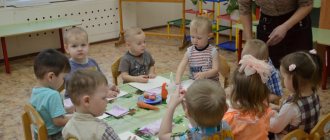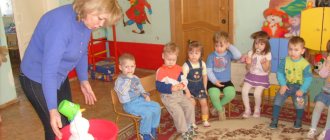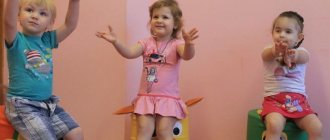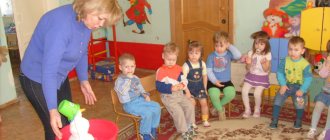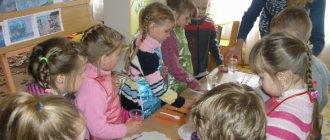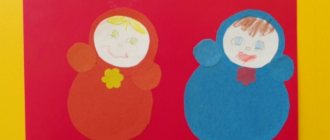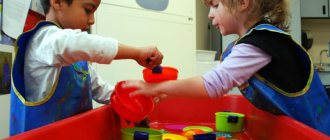Similar files
object(ArrayObject)#852 (1) { ["storage":"ArrayObject":private] => array(6) { [["title"]> string(284) “Perspective work plan Joint activities of the teacher and children in process of regime moments Children’s age 4-5 years (middle group)” ["["seo_title”]t;
string(156) “pierspiektivnyiplantrudovoidieiatielnostisovmiestnaiadieiatielnostvospitatieliaidietieivprotsiessieriezhimnykhmomientovvozrastdietiei45lietsriedniaiaghruppa” [["fi["file_id"]tring(6) “313040” ["["cate["category_seo"]g(2 1) “doshkolnoeObrazovanie” [["su["subcat["subcategory_seo ”]“planirovanie” ["["date["date”]ate["["date”]9” }} object(ArrayObject)#874 (1) { [["st["storag["storage”[" storage”:”ArrayObject”:private]ti["title["title"]i["title["title"]organization of the activities of the senior counselor, types and forms of plans. Organization of the activities of the children's association in the 2015-2016 academic year. ” [ "["seo_["seo_title["seo_title"]["["seo_["seo_title"]-nosti-starshiegho-vozhatogho-vidy-i-formy-planov-orghanizatsiia-dieiatiel-nosti-dietskogho-obiedinieniia-v-2015 -2016-uchiebnom-ghodu” [["fi["file_i["file_id"]e_i["fi["file_id"]"fi["file_i["file_id"]["catego["category_seo"]"ca[" category_seo”]["subcategory["subcategory_seo”]su["subcategory_seo”]"da["date["date"]da["date"]["date"]07dff1eebb25405">
object(ArrayObject)#852 (1) { ["["stor["storage["storage":"ArrayO["storage":"ArrayObjec["storage":"ArrayObject":private]le"["["titl ["title”]l["["title”]s ” [["se["seo_ti["seo_title["seo_title"]["se["seo_title["seo_title"]["seo_title"]["seo_title" ]["file_i["file_id"]"fi["file_id"["file_id"]["file_id"]c[["c["file_id"]a["category_seo"]u["subcate["category_seo"] "su["subcategory_seo”]t["su["subcategory["subcategory_seo”]to see all your works, then you need to log in or register
Labor training in preschool institutions
Labor education of preschool children is one of the most important tasks of a preschool educational institution (DOU). Work in this direction begins from the first days of the baby’s stay in kindergarten.
Work becomes a great educator when it enters the spiritual life of our students, gives the joy of friendship and camaraderie, develops inquisitiveness and curiosity, gives rise to the exciting joy of overcoming difficulties, reveals more and more new beauty in the world around us, awakens the first civic feeling - the feeling of a creator of material wealth , without which human life is impossible.
Goals and objectives of labor education
The main goal of labor education for the youngest visitors to preschool institutions, taking into account their age characteristics, is to develop a positive perception of work and the ability to perform feasible labor actions.
Children should be taught to work from a very early age.
The tasks of labor education at this age are not as extensive as at older ages, but no less important. After all, their attitude towards the most important component of human activity in the future depends on whether the teacher is able to instill respect and love for work in children of the third and fourth year of life. Tasks of labor education in the first and second junior groups of preschool educational institutions:
- Introduce children to professions whose workers they see in real life, in their immediate environment (teacher, nanny, salesman, builder, driver, doctor, cook). In the first junior group, children are given generalized, superficial information: “This is a builder, he builds beautiful, strong, large houses from bricks so that people can live in them.”
- The knowledge that children of the fourth year of life are able to master is presented more fully and deeply. You can point out the connection between professions, name the tools and materials that workers of different professions use in the process of work (“For a builder to build a large store, the driver brought a lot of bricks in his car. When the store is built, sellers will work in it, sell us products, clothes, books, etc.").
- A child of the third year of life, with the help of an adult, masters the ability to wash his hands with soap, use a towel, and a handkerchief.
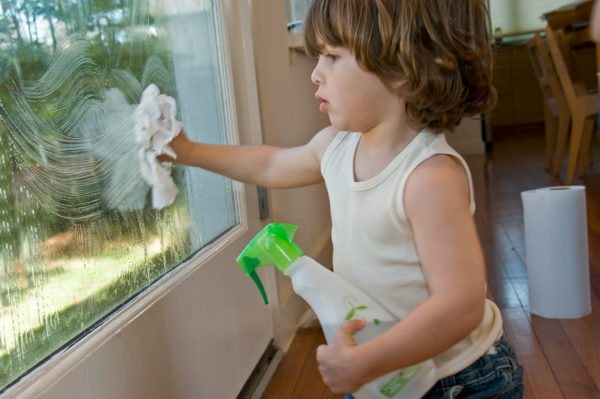
The child’s desire to maintain cleanliness and order is worthy of praise.
- The psychological characteristics of children of the third and fourth years are such that children cannot retain an event in their memory for a long time, so you should not tell them the result of labor designed for the long term (“Now we will plant onions, and when they grow up, we will give them to the kitchen to make soup"). The children will simply forget him. It is better to break such “long-term projects” into stages and communicate the result to children as it approaches. Before planting: “Today we will plant onions, water them, they will grow green and lush.” After the greenery appears: “This is such a good onion that has grown, now I will cut it and give it to the kitchen, where the cook will cook us a delicious soup.” In this way, kids will see the benefits of their work and repeat information about the development and use of vegetables.
Labor education of children in kindergarten is impossible without close interaction with the families of the pupils. Therefore, the teacher needs to think through a set of activities for working with parents: group and subgroup conversations, round tables, exhibitions of literature, thematic folders, etc.
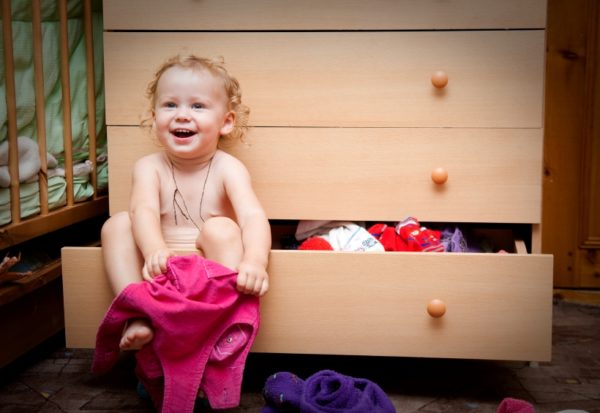
It is important that not only the teacher, but also the parents teach the child to be independent and work
Types and methods of labor education for children of junior groups of preschool educational institutions
In the first and second groups of primary preschool age, the following types of work are used:
- Self-service. This includes washing, undressing and dressing for a walk, going to bed, using the toilet (individual potty), using a handkerchief, towel, napkin, and careful eating.
- Household work: maintaining order in the group room, locker room, bedroom, running errands around the dining room (arranging cups for napkins, bread bins, laying out spoons). In the second junior group, the children are given instructions for preparing classes: arrange plates with handouts, boards for modeling, etc., and then collect them and put them in a certain place. Children can help the teacher in gluing books and game boxes.
- Labor in nature. Children, under the supervision of a teacher, can water plants, wipe large leaves with a damp sponge, loosen the soil in pots, plant onions on feathers, sow large seeds (pumpkins, beans, peas) in boxes.
Manual labor is planned starting from the older group, but it is acceptable to involve younger children in the making of crafts, collective applications, and compositions using various techniques. Kids will be happy to help the teacher make a colorful panel or an original craft to decorate a locker room, group room, or kindergarten lobby.
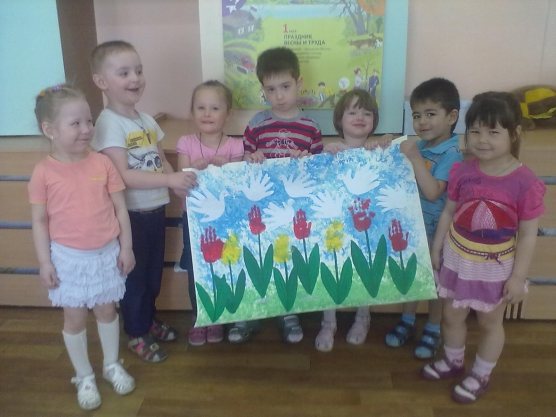
A bright panel made by the students will decorate the group’s locker room
The most acceptable form of work in early preschool age is an assignment, individual or subgroup, when the teacher asks three or four children to do something. In the second case, all children perform the same action, using the same equipment, for example, placing napkin holders on tables, wiping ficus leaves from dust with a sponge. It’s too early to give multifaceted actions (one waters the plant, the other wipes the leaves), they may get confused in the actions or want to do what their neighbor is doing, leaving their part of the work unfinished.
Since children are still very small, their attention is scattered and unstable, the teacher should carefully select methods of motivating work and guiding the activities of students. The most effective techniques are:
- Observation. It is known that in children of the third year of life, imitation is very highly developed, and the main type of activity is object-based. By watching adults act using a variety of objects, the baby repeats after them and thereby learns a new skill. Therefore, it is necessary to organize observations as often as possible of the work of the nanny, janitor, teacher, who perform simple and understandable actions for children: setting the table, sweeping paths, watering flowers, etc.
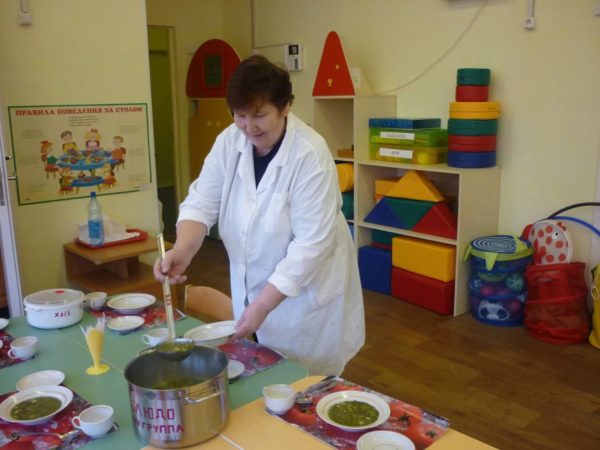
Observing the work of a nanny develops children's understanding of the people who care about them, fosters a sense of gratitude and a desire to help. - Display is closely related to observation. The teacher uses this technique constantly throughout the day when performing all routine moments, since children cannot yet perform actions independently, from memory. Before washing hands, the teacher rolls up the sleeves of his own clothes, and then helps the kids do this. Using soap, shaking water from hands, wiping with a towel, the teacher does this so that all the children can clearly see and understand what should be done.
- In addition to showing, explanation is also necessary. Children need to be told in a simple and understandable form why this or that action is being performed, what its benefits are, what the result will be: “If you each hang clothes on their own chair, they will not wrinkle and it will be easier to find them after sleep.”
- An emotional explanation that encourages a positive result is an excellent motivation for action. Compare 2 sentences: “Now we will wash our hands and dry them with a towel” and “Now we will wash our hands with this fragrant soap, and they will also smell good, become clean, and then we will dry them with a beautiful fluffy towel!” Of course, in the second case, the child will be much more willing to carry out the washing procedure.
- Works of art also help to quickly remember the order of actions and teach children to be neat and tidy. Using them is a very successful technique if the work is not too long and is suitable for a routine moment (dressing, undressing, washing, etc.)
- Creating playful and surprise moments. A favorite toy (a bear, a doll) comes to the children and asks for help, to teach them how to wash their hands, get dressed, and fold things neatly. Or suddenly a new bright comb, decorated with a lush bow, appears and announces that she has come to comb all the dolls in the group. And the children, together with the teacher, comb the dolls’ hair, straighten their outfits, and seat them beautifully in the play corner.
- Creating problematic situations. The game character voices the problem to the children. For example, a bunny comes very sad and reports that all his toys have gone, but in the conversation it turns out that the hero does not know how to fold and put toys in their place. The guys volunteer to help him, teach him how to do it correctly.
- Didactic game. After voicing a problem situation, it is possible to solve it during a didactic game: children “teach” the character to wash hands, put away toys, and perform other labor actions in the games “Toys, in places!”, “What for what?”, “What our hands can do” and others.
- Telling instructive stories compiled by the teacher himself. They should also not be long, loaded with information, but short and appeal to the children’s direct experience: “This morning I found a mitten on the floor in the locker room. She cried because they forgot to put her in the closet. I picked her up, put her in her place and promised that our children would never throw their things on the floor.”
- Encouragement is the most effective and necessary technique in early and early preschool age.
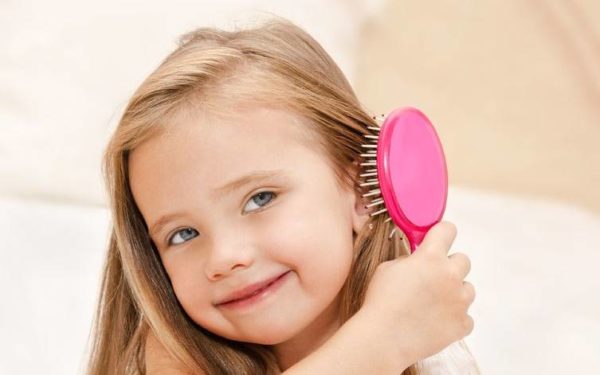
Encouragement is an excellent method of labor education, so you should not skimp on praising children for their neatness and desire for cleanliness.It is necessary to praise children for every small achievement, and even in case of failure, you need to find something positive: “Today you tried to fasten the buttons, and you almost succeeded! We'll practice a little, and soon you'll be able to fasten them all! But you put on the shirt yourself, well done!” By encouraging the child, the teacher reinforces in his memory that work is associated with success. This forms in students a positive attitude towards work in general and makes them want to perform labor actions in the future.
Table: poems for use during routine moments related to children’s self-care
MAGAZINE Preschooler.RF
TOPIC: “NEW YEAR’S BELL” GOAL: INVOLVING CHILDREN INTO DOMESTIC SPIRITUAL AND MORAL TRADITIONS THROUGH THE ORGANIZATION OF ARTISTIC ACTIVITIES. OBJECTIVES: EDUCATIONAL: - TO FAMILIARIZE CHILDREN WITH THE TRADITIONS OF THE RUSSIAN PEOPLE WITH THE FEATURES OF PREPARING AND HOLDING HOLIDAYS. — TO PROMOTE CHILDREN’S COLLECTION — TALK ABOUT THE SEQUENCE OF DEVELOPMENTAL CRAFTS: — TO DEVELOP FINE MOTOR SKILLS OF THE HANDS THROUGH THE SKILLS OF WORKING WITH TINSEL, COLOR FOIL, PLASTIC OBJECTS, WIRE, GLUE. — PROMOTE SPEECH DEVELOPMENT: ENRICHMENT OF VOCABULARY, DEVELOPMENT OF SPEECH COMMUNICATION SKILLS IN ACTIVITY. — PROVIDE HELP IN DEVELOPING SOCIAL SKILLS AND NORDS OF BEHAVIOR, ESTABLISHING COMMUNICATIONS WITH ADULTS AND PEERS IN JOINT ACTIVITIES. EDUCATIONAL: - CULTIVATE A RESPECTIVE, CAREFUL ATTITUDE TO YOUR NEIGHBORHOOD, SKILLS OF FRIENDLY BEHAVIOR, ABILITY FOR EMPATHY. — FORMATION OF A CHILD’S PERSONALITY BASED ON INCLUSION TO THE TRADITIONS OF RUSSIAN CULTURE. PRELIMINARY WORK: - CONSIDERATION OF ILLUSTRATIONS FOR THE NEW YEAR, MEMORIZING POEMS, READING WORKS, LISTENING TO MUSICAL WORKS. MATERIAL: CUT TINSEL, FOIL, GLUE ON PLATES, THIN WIRE, CUT PLASTIC BOTTLES WITH CORK AND ROLL, LETTER, BOX, READY BELL, napkins. PROGRESS OF THE CLASS: CHILDREN PLAY, ADULTS ENTER, SAY HEALTH. TEACHER - HELLO, COME IN, PLEASE, HAVE A SEAT. -GUYS, SAY GREET TO THE GUESTS. SUDDENLY THERE IS A KNOCKING ON THE DOOR, A BUFFIN FLYS IN WITH AN ENVELOPE AND A BOX FROM D. MOROZ AND SAYS. BUFFIN: —THIS IS THE GUYS GR. "STARS?" CHILDREN - "YES" BUFFIN: - SANTA CLAUS GAVE YOU A LETTER AND A BOX, AND I FLY ON ON MY FOREST BUSINESS, "FLY AWAY." TEACHER: - OH, GUYS, WHAT IS IN THIS ENVELOPE? “DECORATED WITH SNOWFLAKES. — DASHENKA, OPEN SOON, NOW WE WILL FIND OUT EVERYTHING, (I LEAN TOWARDS THE GUYS AND READ THE LETTER): “DEAR GUYS, I HAVE MISSING TOYS FOR THE MAIN TREE OF THE VILLAGE. ORICHI. I ASK YOU, PLEASE HELP TO MAKE NEW CHRISTMAS TOYS. GRANDFATHER COLA" TEACHER: (PAYING ATTENTION TO THE BOX) - GUYS, WHAT'S IN THE BOX, LET'S OPEN IT. THERE IS ONE TOY LEFT HERE, SO BEAUTIFUL! WHAT IS THIS? BELL (MUSIC SOUNDS) - HOW IS IT MADE? WHAT DOES IT CONSISTE OF? (THE TAB IS ON A THIN WIRE AND THE TAP IS OPENED, AND IT’S DECORATED SO BEAUTIFULLY: - STARS, CIRCLES. - LET’S SPIN ON YOUR TOES TO THE RINGING OF THE BELL (MUSIC SOUNDS) THE CHILDREN RAN IN A CIRCLE. - GUYS, AND WE ARE WITH YOU LET'S HELP GRANDFATHER CLAUS MAKE A NEW YEAR'S BELL? THEN LET'S STRETCH OUR FINGERSPHYSICIST: “1 2 3 4 5 — CONNECT THE FINGERS OF THE SAME HANDS WE WILL DECORATE THE TREE — SHOW “THREE TREE” — INTERLOCK THE FINGERS. BEADS, BALLS, TOYS - BEND YOUR FINGERS INTO A FIST RAIN, STARKS, CRAPPERS FIR IN THE GLOW OF LIGHTS Squeeze and unclench the “Pinch” YOU CAN INVITE GUESTS - COTTON, THEN Stretch your arms forward with your palms
TEACHER - NOW TAKE THE BLANK BLANKS YOU WANT, CHOOSE YOUR PLACE AT THE TABLE AND SIT DOWN - SEE WHAT ELSE IS ON THE TABLE? (GLUE, THICK AND THIN WIRE, FOIL, SLICED TINSEL) - TEACHER - YOU KNOW GUYS, I ALSO WANT TO MAKE SUCH A BELL FOR D. MOROZ, HE WILL BE VERY PLEASANT, JUST YOU TELL ME IF I FORGET SOMETHING. (I SPEAK EVERY ACTION) - WHAT WILL WE MAKE THE TONGUE FROM? CHILDREN: (FOIL) TEACHER - WHAT A GOOD YOU ARE, YOU NEED TO CRUSH IT IN YOUR PALM. - GUYS, WHAT DO YOU FEEL IN YOUR PALM? I AM ALSO TINGING AND COLD, AND I NEED TO ROLL THE BALL ROUND. -AND NOW, WHAT WIRE IS BETTER FOR US TO TAKE? (THIN) TEACHER - I ALSO THINK SO, IT’S MORE CONVENIENT TO SCREW THE TONG. - LOOK WHAT WONDERFUL BALLS TURNED OUT AND HOW THEY SWING! WE WRAP THE BALL WELL WITH THIN WIRE, LOOK, I WILL SHOW. - HOW DO WE MAKE SO THAT THE TONGUE IS INSIDE THE BELL? CHILDREN: - (THROUGH THE NECK, OR PUSH IT IN FROM THE TOP) TEACHER - CORRECT! WHAT A GOOD YOU ARE! - GUYS, I CAN HEAR MY BELL RINGING, AND YOU? LET'S CALL, SO GREAT. CHILDREN: - IT’S RINGING FOR ME TOO..... TEACHER: - THE BELL IS READY, CAN WE DECORATE THE TREE, OR IS SOMETHING MISSING HERE? CHILDREN: - DECORATE TEACHER: - OF COURSE, YOU'RE RIGHT, BECAUSE THE NEW YEAR IS SOON, EVERYTHING SHOULD SHINE AND SPARKLE, AND PLEASURE THE EYE. YOU HAVE SELF-ADHESIVE FOIL FIGURES ON YOUR TABLE, TAKE ANY COLOR, CAREFULLY BEND THE CORNER, REMOVE THE BOTTOM LAYER AND GLUE TO YOUR BELL. DECORATE AS YOU WANT. TEACHER: - LIFT IT, ADMIRE IT’S BEAUTIFUL, BUT SOMETHING ELSE IS MISSING... AND I KNOW THE SECRET OF HOW TO MAKE OUR BELL EVEN MORE BEAUTIFUL. LOOK: LIKE THIS, THEY DIPPED INTO PLATES WITH GLUE, AND THEN INTO CUT UP TINSEL, THEY ARE LIKE STICKS - OH, WHAT A BEAUTY YOU HAVE, MARINA... D. FROST WILL DEFINITELY LIKE OUR BELLS. - DO YOU GUYS LIKE THEM? CHILDREN: - LIKE IT VERY MUCH. TEACHER: - THEN TAKE YOUR BELLS IN YOUR HANDS, ADMIRE, WALK WITH THEM. (MUSIC SOUNDS) - NOW LET'S PUT THEM IN THIS BEAUTIFUL BOX AND SEND THEM TO D. MOROZA. (CHILDREN CAREFULLY PLACE THEIR BELLS IN A BEAUTIFUL BOX) TEACHER: - THIS IS HOW HAPPY D.MOROS WILL BE! HE WILL BE SURE TO DECORATE THE MAIN TREE OF THE VILLAGE WITH OUR NEW YEAR'S TOYS, AND YOU AND I WILL GO TO ADMIRE OUR BELLS.
| Next > |
Labor activity in the second junior group of preschool educational institutions
Children of the fourth year of life can perform more labor activities both indoors and outdoors. For example, they have access to:
- Wiping dust off shelves, arranging toys and books.
- Assisting the teacher in preparing for classes (arranging and collecting material).
- Cleaning up leaves in the fall and snow in the winter, but these tasks should be brief, and during them the teacher should carefully monitor the condition of the children, avoiding overload. The best option would be to clear one or two benches of snow or sweep a short path.
- Laying out counting material and pencils in boxes and cups.
- Dressing and combing dolls, cleaning large construction toys and cars.
- Participation in the creation of crafts and collective decorative compositions.
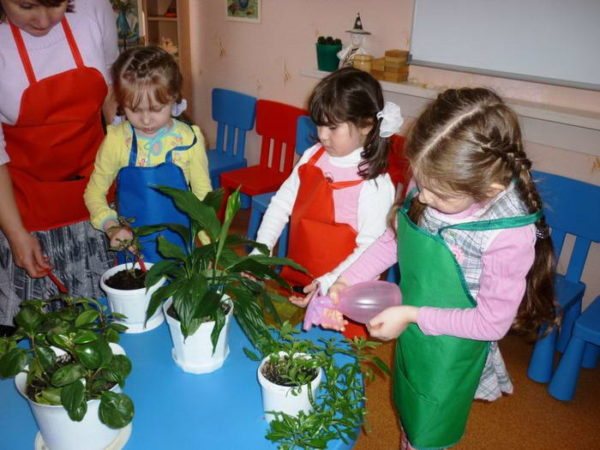
Children of the fourth year of life can be entrusted with caring for indoor plants under the supervision of a teacher.
Time is allocated for household chores in the afternoon. Its duration does not exceed 15 minutes. To engage in work related to water, children must be dressed in oilskin aprons that protect their clothing; all tools and materials for work must be stored in an accessible place. When drawing up a long-term plan for work activity, it does not have to be tied to the topic of the block (week, month). The teacher can choose those types of training that he considers necessary to pay more attention to.
Table: example of long-term planning of work activity in the second junior group of a preschool educational institution (fragment)
Table: example of a lesson summary on labor education with children of the fourth year of life
Video: lesson on household work in the younger group
Summary of a lesson on manual labor in the middle group of kindergarten
Summary of a lesson on manual labor in the middle group of children
Sada
Topic: Frog (origami technique)
Goals: — formation of a holistic picture of the world
- introduce to verbal art
— enrichment and activation of the dictionary.
- to develop the ability to understand cause and effect relationships in the text read
- to form a stable interest in the reading process and memorizing what has been read.
— Promote the development of a caring attitude towards living nature
- continue to teach how to perform movements in accordance with the text.
— We continue our acquaintance with the origami paper folding technique.
— to develop the ability to design according to plan, taking into account the characteristics of the material.
- development of fine motor skills
- encourage and strengthen the desire to work.
— Teach children to be happy with the result.
Material: text of N. Sladkov’s story “Zhaleikin and the Little Frog”, illustrations for the story
handout: green origami sheet, felt-tip pens.
Preliminary work: looking at pictures of frogs; Didactic games “Who lives in the water”, “The fourth odd one”; Reading fiction: about mammals that live in water; outdoor game "Frogs".
Program content:
Guys, listen to one very interesting story written by Nikolai Sladkov.
This story is called “Zhaleikin and the Frog”
Under a hummock in a damp swamp, Zhaleikin noticed a small, weak frog. - Poor, unfortunate baby! – exclaimed Zhaleikin. - How bad it is for you, poor thing, in this dirty swamp! Dark, damp, cold! But don't be discouraged! I will save you, you will feel good and cozy in my home. At home, Zhaleikin put the little frog in the most beautiful painted box, laid soft dry cotton wool on the bottom, put the box in the warm sun and laughed cheerfully with joy. - Remember, little frog, my worries! You will now live in warmth, dryness and cleanliness. Not like in your dirty swamp! But the frog is not happy. But the frog is not having fun. He feels very bad, he is barely alive. It overheated in the sun, dried out and became entangled in cotton wool. When Zhaleikin saw him, he roared. He poured tears all over the little frog, and just in time: a little more and the little frog would have died. Zhaleikin rushed with the frog to the swamp. The very same place where it’s damp, dirty and cold, but where the frog feels just as good as Zhaleikin in his warm and clean room.
Guys, what is the name of the story you just listened to? (Zhaleikin and the frog)
Who is it about?
What did Zhaleikin do? (took the frog from the swamp to his home)
Was the little frog happy? What happened to him? (the little frog overheated in the sun, dried out and almost died. The little frog feels bad at Zhaleikin’s house)
What did Zhaleikin do? (carried the frog back to the swamp)
Why can't frogs be taken from the swamp? (because the swamp is the home of frogs, they feel good and cozy there)
Guys, let's make a frog that will be good in our home. We will make it from paper using the origami technique. But first, we will imagine ourselves as little frogs:
Physical school
Here is a frog jumping along the path with its legs stretched out. She saw a mosquito and screamed...Kwa-Kwa-Kwa!
Now come to your tables - let's start designing.
Now you need to draw the frog’s eyes. To do this, take felt-tip pens.
That's how beautiful our frogs turned out to be. And most importantly, such frogs will be very happy in our home. You did a very good job, Well done guys.

Summary of a lesson on manual labor in the middle group of kindergarten
Topic: Bed for Katya doll
Objectives: - to teach to understand the general word “furniture”.
- expand and activate the vocabulary on the topic.
— consolidation of the formation of diminutive forms of nouns.
- Improve your ability to solve riddles.
- continue to teach how to perform movements in accordance with the text.
— teach to perform morally oriented actions (help Katya the Doll).
— to develop the ability to design according to plan, taking into account the characteristics of the material.
— improve the ability to work with scissors.
— teach to follow the instructions of an adult when performing work with hazardous
tools and materials (scissors, glue).
- encourage and strengthen the desire to work.
— Teach children to be happy with the result.
— Development of creative imagination.
Material: ball, Katya doll (small), pictures depicting pieces of doll furniture;
Handout: matchboxes (4 pieces each), colored cardboard, pieces of fabric according to size
cribs, scissors, glue, glue brush, wet wipes, oilcloths.
Preliminary work: conversation on the topic “Furniture”, “What is in our group”; guessing
riddles on the theme “Furniture”, “Toys”; role-playing game "Family"
"Mothers and Daughters"; work assignment: clean up the doll house
Program content:
Guys, let's play a game called “Call it kindly.” I will throw you a ball and say a word, and you will say the same word, but affectionately, and throw the ball back to me. For example, a carpet is a rug.
What a great fellow you are. Everyone knows kind words.
Guys, I’ll tell you a secret that a guest is coming to us today. But for now this guest is delayed. Let's guess who should come to us:
I'm a good toy, I'll be a girls' friend. I can sit in a stroller, I can close my eyes. I ask you to love me, not to drop me, not to hit me. (Doll)
Yes guys, this is a doll.
(There is a knock on the door.)
Educator: And here is our little guest (brings in a doll). Let's say hello to her.
This is Katya doll. She has long wanted to meet you. Let's ask where Katya lives.
Katya lives in a toy country in her dollhouse.
Katya, tell us about your house.
Katya says (the teacher changes her voice): My house is very beautiful and cozy. I will show you in pictures what is in my house. And you say what you see on them.
(The doll shows pictures of furniture. Only the bed is missing. Children name all the pieces of furniture.)
Well done boys. Now name in one word what you saw in the pictures. That's right, guys, it's furniture.
Have you noticed that one piece of furniture is missing from Katya’s house? Which one? (if the children find it difficult, the teacher prompts).
There is no bed in Katya's house and she has nothing to sleep on. Let's help Katya and make a good bed for her.
First we need to charge:
Physical school
| Chair and table, sofa, chest of drawers - | We bend our fingers while listing the furniture. |
| The people are calling for furniture! | Show your palms. |
| Our closet serves to | Spread your arms to the sides. |
| To put laundry there! | Arms bent at the elbows in front of the chest (upward movements). |
| What is the bed for? | Extend your arms to the sides. |
| So that you can sleep comfortably! | Place your palms under your cheek. |
| Furniture creates comfort | Hands on the belt, turns with half squats to the right - left (4 times). |
| And in the country, in the house, here! | Spread your arms to the sides. |
The exercises are done, now you can start constructing the furniture. Katya will choose the most beautiful crib and sleep on it in her house.
We will make a crib for Katya from matchboxes, cardboard and a piece of fabric. Go to your workstations and let's get started.
First, we will glue matchboxes together to form a mattress. Take the cardboard and cut it along the line into two unequal parts. Glue them at the two narrow ends. These are the headboards. Then we glue a piece of fabric to make the crib beautiful. Whose crib is ready, place it next to Katya. Let her admire it.
Well, all the beds are ready. Katya looked at them and couldn’t choose the most beautiful one. She really liked all the cribs. Let us give Katya and her doll friends everything we have made.
Look how happy and happy Katya is. She says thank you. She can't wait to show the cribs to her friends. And we will say goodbye to her, and we will wait for her to visit again.
Analysis of work activity in the junior group
To assess a child's ability to care, not to be lazy and to work, a game is played, participation in which takes a long time. The most common game among educators is the game “Our Garden.”
Pupils are encouraged to plant certain seeds and care for them until they sprout. The resulting seedlings, together with the teacher, are planted on the territory of the preschool educational institution or in pots in a group.
Interesting! Prospective analysis makes it possible not only to identify children who are incapable of caring for children, but also to clearly tell children about how some common fruits, vegetables, and herbs are grown.
Diagnosis of diligence control
Throughout the year, from time to time, during walks or in a group, children are offered work of a different nature, within their capabilities. The teacher, in a playful way, asks the children to wipe dust from the foliage of indoor plants, encouraging them with praise about how big boys and girls have grown and can do everything, but their mutual friend Dunno does not know how to water flowers or wipe dust. All the action takes place in front of the teacher, but after several training sessions the children themselves must pour water into watering cans, wet rags and take care of the flowers.
Attention! While the pupils are fascinated by the process, the teacher fills out a diagnostic card for the group, in which he makes notes on how quickly everyone figured out where to get water, how to identify plants that needed watering, and which of the preschoolers helped a friend and who accepted this help.

Plant care
Project activities for labor education of younger preschoolers
Since in project activities with younger students the leading role belongs to the teacher, and the kids assimilate information and take the first steps in search and research activities, it is advisable to plan a labor education project that is informational, introducing adults to the professions (driver, builder, doctor), or playful, enriching children's experience with new games related to professions and performing work assignments, self-service. Due to the fact that younger preschoolers do not have sufficiently developed long-term memory, it is better to plan short-term projects, lasting 1-2 weeks.
Project activities go through the following stages:
- When preparing to implement a project, the teacher must think through the topic and goal, as well as whether they correspond to the age of the children, whether the kids will be able to successfully complete all the points of the future project, and what results are expected.
- At the second stage (project development), the teacher determines ways to achieve the goals and objectives, selects materials, equipment, and information sources. Next comes the actual implementation of the project. Children, with the help and direct participation of the teacher, carry out the planned forms of work, which leads to the expected result.
- The final stage (presentation) of the project takes place with the participation of children. The product of an information project can be an album or a mobile folder, which will reflect the information learned by children, while a game project can be attributes for directorial and plot games.
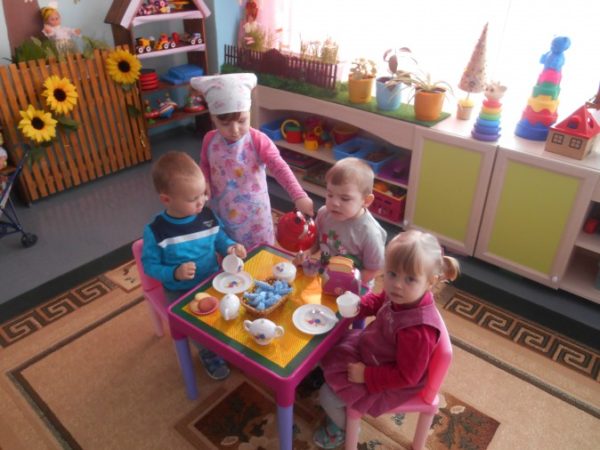
Getting to know any profession can be done in a playful way
Table: example of a pedagogical project in a junior group
Junior group. Early childhood, nursery. Children 1-4 years old
Program for labor education of children from 1 year to 3 years old “Merry Garden” Explanatory note Labor education of the younger generation is one of the most important tasks of our society. An active, purposeful person, capable of self-realization, creativity, satisfying his interests in his chosen business and self-improvement is...
Labor education of young children in a preschool educational organization Labor plays an important role both in the life of society as a whole and in the process of developing a person’s personality. It is a complex activity , the implementation of which requires a certain level of physical and mental development. Preparing a child for future work ...
Methods and techniques of labor organization
According to the Federal State Educational Standard, from a very young age children must be taught measured independence and hard work. During each routine day, children perform a number of tasks that, in addition to their direct function, are capable of developing ingenuity and memory. For example, when a junior teacher asks for help in setting the table for dinner with cutlery from someone in the group, the young assistant involuntarily remembers which of his friends is sitting on one side of the table and which on the other, who has already been provided with a spoon and who has not yet.
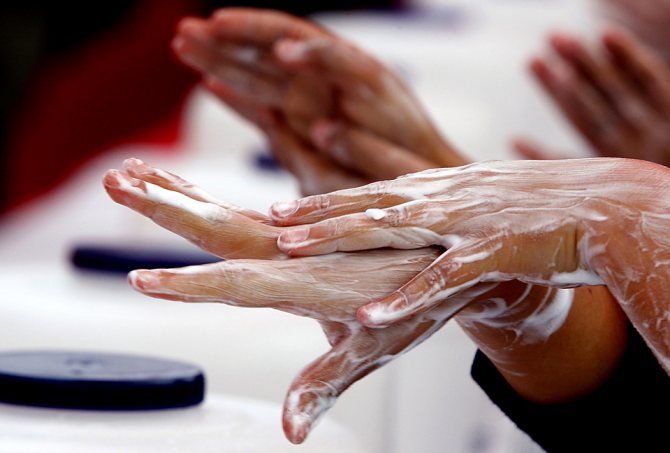
White soap gloves
The most common method is asking for help: an inexperienced and upset toy who finds herself in a difficult situation asks for help from the guys, and they willingly help her.
Additional Information! With a little trick, you can get children interested in washing their hands; to do this, the teacher shows how to use soap and water to make beautiful white gloves that have magical powers - they cleanse the skin of dirt and bacteria.
It’s easy to instill in children respect for work if you choose the moment to start learning and follow a simple rule - children do everything while playing. If parents at home manage to turn an important task into a game, the child will play profitably without resistance.
Analysis and diagnosis of labor activity in junior groups of preschool educational institutions
Analysis and control of the level of labor education and children’s mastery of skills is necessary, first of all, for the teacher himself in order to control the situation in the group and know in which direction to carry out individual work, what to pay special attention to. To monitor the level of children’s skills and abilities, it is recommended to fill out diagnostic cards twice a year, in the fall (in September-October) and in the spring (in April-May).
Table: diagnostic chart for monitoring the level of mastery of labor skills in children of the third and fourth year of life
A teacher working with younger preschoolers is entrusted with an important task: from an early age to accustom children to feasible work, to cultivate respect for working specialists, and a desire to grow by helping others. The attitude of children to work in subsequent years depends on how seriously and thoughtfully the teacher approaches the fulfillment of this responsibility. Therefore, all efforts should be made to develop in children the concept that work is important and necessary, and that working is useful and exciting. Having received such a life attitude in early childhood, the child will be able to steadfastly overcome temporary adversity, will easily study at school and find his place in life.
- Author: Marina Yakovleva
Rate this article: (9 votes, average: 3.2 out of 5)
Labor education. Labor activity of children - Labor education of young children
Publication “Labor education of young children...” Labor education of young children Goal: to form in children a positive attitude towards work. Types of work: •self-service; •socially – useful work. In early age groups, children’s work is organized in the form of individual assignments, which they carry out together with...
Self-care as the beginning of the working life of a 3-4 year old child - Why is work activity needed? — How does labor activity develop? “Education should not only develop the mind, equip it with knowledge, but also ignite in a person a thirst for serious work, without which his life can be neither worthy nor happy” K. D. Ushinsky….
Labor while walking. Cleaning up fallen leaves (second junior group)
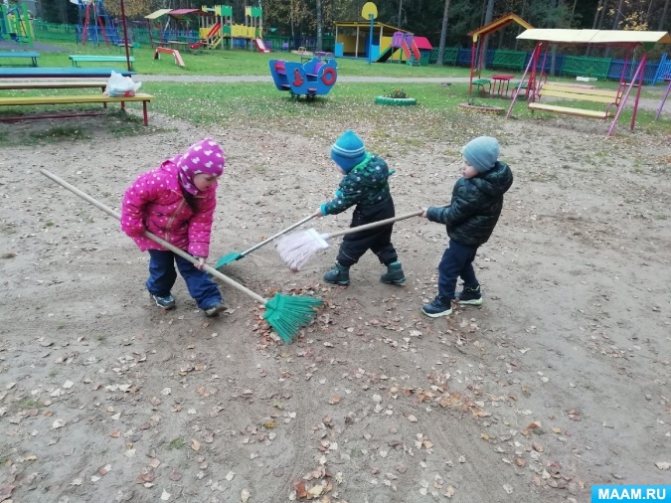
Labor while walking. Cleaning up fallen leaves (second junior group) Conducted by: Denisova I.G. Labor education in kindergarten is a mandatory process, thanks to which the child develops a positive attitude towards work, develops the desire and ability...
Technological map of thematic control “Organization of work of preschool children in nature.” Second junior group Date Topic Content 10/07/2022 "Organization of work of preschool children in nature." Second junior group Tasks: to form a positive attitude towards natural objects; consolidate primary knowledge about the animals of the corner of nature, their needs for food, water, warmth; build skills...
